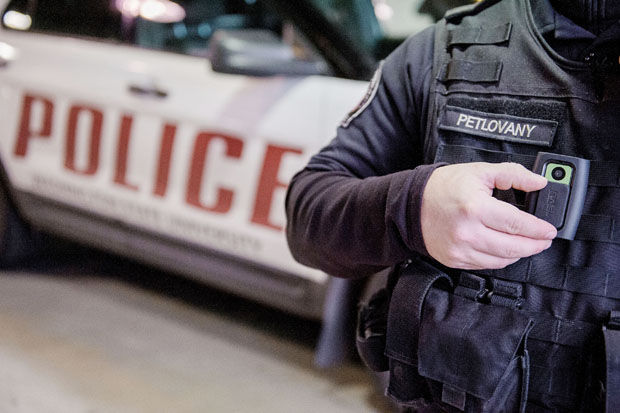Undergraduates will study connection between race, policing
Student data will be shared with police agencies; WSU faculty will mentor students
Police officer Michael Petlovany of the Washington State University Police Department demonstrates how his body camera operates Febuary 20th, 2013.
July 11, 2022
Undergraduate researchers will analyze disparities in body-worn camera footage from police officers in 2023, funded by a $433,081 grant for WSU’s Complex Social Interactions Lab.
For nine weeks, students from different universities across the nation will live on campus and collaborate in small teams to design research projects. They will receive mentorship from WSU faculty who will help students develop research topics and techniques, said Dale Willits, criminal justice associate professor and graduate program director.
“By opening this to students that come from different universities, you build research teams that have depth to them that might not otherwise exist from just a single university,” he said.
Undergraduates from any major who are interested in policing and have some research experience can contact the CSI through its website. The research project is facilitated by the Research Experiences for Undergraduates program, which is supported by the National Science Foundation, Willits said.
In the laboratory, students will watch body-worn camera footage of real police interactions and take records of what happened and in what contexts. They will be able to compare this data to what is expected according to code books to help develop theories relating to policing techniques, said David Makin, associate professor of criminal justice and laboratory director.
“[We are] working with undergraduate and graduate students, teaching them how to operationalize body-worn camera data,” he said.
He said the data collected and theories developed by the lab are shared with police agencies to help guide their practices. The lab has partnerships with multiple agencies, including the Pullman Police Department.
He said it is important for police to review their footage to help improve their ability to police, much like an athlete reviews tape to improve their game.
“Half of all police departments have body-worn camera programs, but very few of them actually integrate them into their practices,” he said.
While recording body-worn camera footage has been common practice for about 10 years, collecting and using objective data from the footage is still in development, he said.
A major focus in the lab is the unequal policing of different population groups depending on their race and background, Willits said.
“This idea of differential policing is that different groups in society have different exposures to police as a matter of practice,” he said.
For example, Willits said Black people are subject to disproportionate contact — police stopping them at a higher rate than other racial groups.
In 2019, Black adults were about five times more likely to say they have been unfairly stopped by the police due to their race or ethnicity than white adults, according to the Pew Research Center. That same year, Stanford University found that Black drivers are 20% more likely to be pulled over than white drivers in a study of nearly 100 million U.S. traffic stops within a 16-year period.
When police officers stop individuals, Makin said there are observable inequities in identification requests. Officers are expected to provide an explanation for why they stopped someone before asking for identification, but they often ask for identification first and withhold any explanation, depending on the individual.
“With certain members of the community, they want your ID first,” he said.
In addition to researching and attending events from the WSU Undergraduate Research Center, Makin said students will also interact with faculty from multiple disciplines. While much of the faculty involved is in the criminal justice department, there are also quantitative, public health and library access resources that students will use to give the analysis depth.
“This is not just a criminal justice project,” he said. “This is broader than that. We’re going to try to involve faculty from different disciplines to give students as broad of an experience with research and research methods as possible.”










